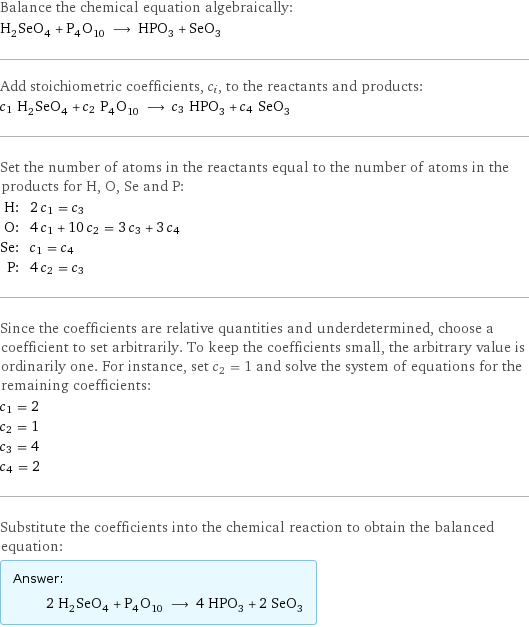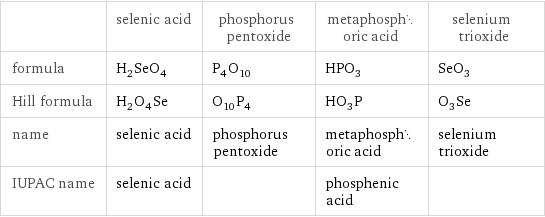Input interpretation

H_2SeO_4 selenic acid + P_4O_10 phosphorus pentoxide ⟶ HPO_3 metaphosphoric acid + SeO_3 selenium trioxide
Balanced equation

Balance the chemical equation algebraically: H_2SeO_4 + P_4O_10 ⟶ HPO_3 + SeO_3 Add stoichiometric coefficients, c_i, to the reactants and products: c_1 H_2SeO_4 + c_2 P_4O_10 ⟶ c_3 HPO_3 + c_4 SeO_3 Set the number of atoms in the reactants equal to the number of atoms in the products for H, O, Se and P: H: | 2 c_1 = c_3 O: | 4 c_1 + 10 c_2 = 3 c_3 + 3 c_4 Se: | c_1 = c_4 P: | 4 c_2 = c_3 Since the coefficients are relative quantities and underdetermined, choose a coefficient to set arbitrarily. To keep the coefficients small, the arbitrary value is ordinarily one. For instance, set c_2 = 1 and solve the system of equations for the remaining coefficients: c_1 = 2 c_2 = 1 c_3 = 4 c_4 = 2 Substitute the coefficients into the chemical reaction to obtain the balanced equation: Answer: | | 2 H_2SeO_4 + P_4O_10 ⟶ 4 HPO_3 + 2 SeO_3
Structures

+ ⟶ +
Names

selenic acid + phosphorus pentoxide ⟶ metaphosphoric acid + selenium trioxide
Equilibrium constant
![Construct the equilibrium constant, K, expression for: H_2SeO_4 + P_4O_10 ⟶ HPO_3 + SeO_3 Plan: • Balance the chemical equation. • Determine the stoichiometric numbers. • Assemble the activity expression for each chemical species. • Use the activity expressions to build the equilibrium constant expression. Write the balanced chemical equation: 2 H_2SeO_4 + P_4O_10 ⟶ 4 HPO_3 + 2 SeO_3 Assign stoichiometric numbers, ν_i, using the stoichiometric coefficients, c_i, from the balanced chemical equation in the following manner: ν_i = -c_i for reactants and ν_i = c_i for products: chemical species | c_i | ν_i H_2SeO_4 | 2 | -2 P_4O_10 | 1 | -1 HPO_3 | 4 | 4 SeO_3 | 2 | 2 Assemble the activity expressions accounting for the state of matter and ν_i: chemical species | c_i | ν_i | activity expression H_2SeO_4 | 2 | -2 | ([H2SeO4])^(-2) P_4O_10 | 1 | -1 | ([P4O10])^(-1) HPO_3 | 4 | 4 | ([HPO3])^4 SeO_3 | 2 | 2 | ([SeO3])^2 The equilibrium constant symbol in the concentration basis is: K_c Mulitply the activity expressions to arrive at the K_c expression: Answer: | | K_c = ([H2SeO4])^(-2) ([P4O10])^(-1) ([HPO3])^4 ([SeO3])^2 = (([HPO3])^4 ([SeO3])^2)/(([H2SeO4])^2 [P4O10])](../image_source/1e335351446f8faff43fd521edba6403.png)
Construct the equilibrium constant, K, expression for: H_2SeO_4 + P_4O_10 ⟶ HPO_3 + SeO_3 Plan: • Balance the chemical equation. • Determine the stoichiometric numbers. • Assemble the activity expression for each chemical species. • Use the activity expressions to build the equilibrium constant expression. Write the balanced chemical equation: 2 H_2SeO_4 + P_4O_10 ⟶ 4 HPO_3 + 2 SeO_3 Assign stoichiometric numbers, ν_i, using the stoichiometric coefficients, c_i, from the balanced chemical equation in the following manner: ν_i = -c_i for reactants and ν_i = c_i for products: chemical species | c_i | ν_i H_2SeO_4 | 2 | -2 P_4O_10 | 1 | -1 HPO_3 | 4 | 4 SeO_3 | 2 | 2 Assemble the activity expressions accounting for the state of matter and ν_i: chemical species | c_i | ν_i | activity expression H_2SeO_4 | 2 | -2 | ([H2SeO4])^(-2) P_4O_10 | 1 | -1 | ([P4O10])^(-1) HPO_3 | 4 | 4 | ([HPO3])^4 SeO_3 | 2 | 2 | ([SeO3])^2 The equilibrium constant symbol in the concentration basis is: K_c Mulitply the activity expressions to arrive at the K_c expression: Answer: | | K_c = ([H2SeO4])^(-2) ([P4O10])^(-1) ([HPO3])^4 ([SeO3])^2 = (([HPO3])^4 ([SeO3])^2)/(([H2SeO4])^2 [P4O10])
Rate of reaction
![Construct the rate of reaction expression for: H_2SeO_4 + P_4O_10 ⟶ HPO_3 + SeO_3 Plan: • Balance the chemical equation. • Determine the stoichiometric numbers. • Assemble the rate term for each chemical species. • Write the rate of reaction expression. Write the balanced chemical equation: 2 H_2SeO_4 + P_4O_10 ⟶ 4 HPO_3 + 2 SeO_3 Assign stoichiometric numbers, ν_i, using the stoichiometric coefficients, c_i, from the balanced chemical equation in the following manner: ν_i = -c_i for reactants and ν_i = c_i for products: chemical species | c_i | ν_i H_2SeO_4 | 2 | -2 P_4O_10 | 1 | -1 HPO_3 | 4 | 4 SeO_3 | 2 | 2 The rate term for each chemical species, B_i, is 1/ν_i(Δ[B_i])/(Δt) where [B_i] is the amount concentration and t is time: chemical species | c_i | ν_i | rate term H_2SeO_4 | 2 | -2 | -1/2 (Δ[H2SeO4])/(Δt) P_4O_10 | 1 | -1 | -(Δ[P4O10])/(Δt) HPO_3 | 4 | 4 | 1/4 (Δ[HPO3])/(Δt) SeO_3 | 2 | 2 | 1/2 (Δ[SeO3])/(Δt) (for infinitesimal rate of change, replace Δ with d) Set the rate terms equal to each other to arrive at the rate expression: Answer: | | rate = -1/2 (Δ[H2SeO4])/(Δt) = -(Δ[P4O10])/(Δt) = 1/4 (Δ[HPO3])/(Δt) = 1/2 (Δ[SeO3])/(Δt) (assuming constant volume and no accumulation of intermediates or side products)](../image_source/66f0025b77036cc92da3e6bc6bae6138.png)
Construct the rate of reaction expression for: H_2SeO_4 + P_4O_10 ⟶ HPO_3 + SeO_3 Plan: • Balance the chemical equation. • Determine the stoichiometric numbers. • Assemble the rate term for each chemical species. • Write the rate of reaction expression. Write the balanced chemical equation: 2 H_2SeO_4 + P_4O_10 ⟶ 4 HPO_3 + 2 SeO_3 Assign stoichiometric numbers, ν_i, using the stoichiometric coefficients, c_i, from the balanced chemical equation in the following manner: ν_i = -c_i for reactants and ν_i = c_i for products: chemical species | c_i | ν_i H_2SeO_4 | 2 | -2 P_4O_10 | 1 | -1 HPO_3 | 4 | 4 SeO_3 | 2 | 2 The rate term for each chemical species, B_i, is 1/ν_i(Δ[B_i])/(Δt) where [B_i] is the amount concentration and t is time: chemical species | c_i | ν_i | rate term H_2SeO_4 | 2 | -2 | -1/2 (Δ[H2SeO4])/(Δt) P_4O_10 | 1 | -1 | -(Δ[P4O10])/(Δt) HPO_3 | 4 | 4 | 1/4 (Δ[HPO3])/(Δt) SeO_3 | 2 | 2 | 1/2 (Δ[SeO3])/(Δt) (for infinitesimal rate of change, replace Δ with d) Set the rate terms equal to each other to arrive at the rate expression: Answer: | | rate = -1/2 (Δ[H2SeO4])/(Δt) = -(Δ[P4O10])/(Δt) = 1/4 (Δ[HPO3])/(Δt) = 1/2 (Δ[SeO3])/(Δt) (assuming constant volume and no accumulation of intermediates or side products)
Chemical names and formulas

| selenic acid | phosphorus pentoxide | metaphosphoric acid | selenium trioxide formula | H_2SeO_4 | P_4O_10 | HPO_3 | SeO_3 Hill formula | H_2O_4Se | O_10P_4 | HO_3P | O_3Se name | selenic acid | phosphorus pentoxide | metaphosphoric acid | selenium trioxide IUPAC name | selenic acid | | phosphenic acid |
Substance properties

| selenic acid | phosphorus pentoxide | metaphosphoric acid | selenium trioxide molar mass | 144.98 g/mol | 283.89 g/mol | 79.979 g/mol | 126.97 g/mol phase | | solid (at STP) | liquid (at STP) | solid (at STP) melting point | | 340 °C | 21 °C | 118.35 °C boiling point | | | 260 °C | density | 2.511 g/cm^3 | 2.3 g/cm^3 | 2.4 g/cm^3 | 3.6 g/cm^3 solubility in water | | | soluble | very soluble
Units
